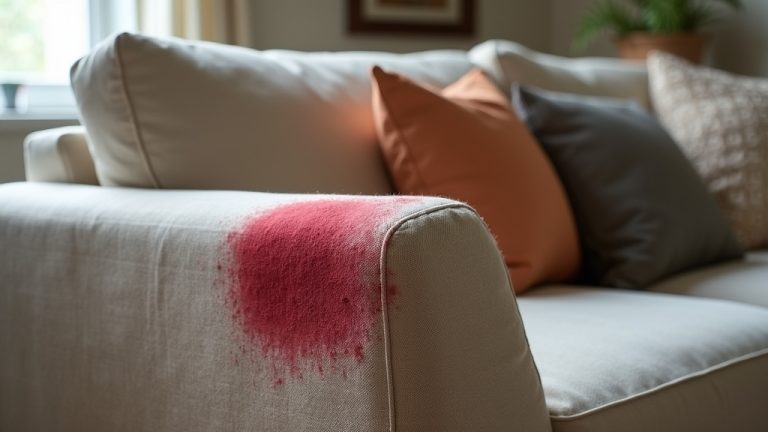How Do You Clean Shower Door Tracks? Simple DIY That Works
To clean shower door tracks, start by removing loose debris with a vacuum or cloth. Spray a vinegar-water solution and let it sit 10–30 minutes to loosen grime.
Apply baking soda paste on stubborn spots, then scrub with a toothbrush or grout brush. Rinse with distilled water and dry thoroughly with a microfiber cloth to prevent mold.
Regular squeegeeing and ventilation help maintain cleanliness. With these basics in hand, you can tackle deeper buildup and lasting grime effectively.
Key Takeaways
- Remove loose debris and hair from shower door tracks using a vacuum or dry cloth before cleaning.
- Apply white vinegar or a vinegar-water solution to dissolve soap scum and mineral deposits, letting it sit 10–30 minutes.
- Scrub tracks with an old toothbrush or grout brush, focusing on corners and grooves to remove grime and buildup.
- Use baking soda paste for stubborn stains, letting it sit 30–60 minutes before scrubbing and rinsing thoroughly.
- Dry tracks completely with a microfiber cloth and maintain regular cleaning to prevent mold and soap scum buildup.
Essential Cleaning Supplies for Shower Door Tracks
When cleaning shower door tracks, you’ll want to gather specific supplies tailored to your cleaning needs.
For basic cleaning, keep white vinegar handy to break down soap scum and mineral deposits. Use cotton balls to apply vinegar without oversaturating, and a grout brush or old toothbrush to scrub away grime.
A microfiber cloth will help dry the tracks and prevent water spots, while a spray bottle with distilled water rinses off residues. Be cautious to avoid excessive flooding of the tracks by using minimal vinegar.
For tougher stains, add baking soda for scrubbing power, and consider a steam cleaner for deep sanitizing. Rubber gloves protect your hands during intense cleaning.
Specialized tools, like shower track brushes and plastic spatulas, help remove stubborn debris. Finally, maintain cleanliness regularly with soft brushes and microfiber cloths to prevent buildup.
Preparing Shower Door Tracks for Cleaning
Gathering the right supplies sets you up for success, but you’ll want to prepare the shower door tracks thoroughly before applying any cleaners. Start by removing all loose debris like dirt, hair, and dust using a vacuum with a nozzle or a dry cloth, focusing on corners and grooves.
Begin by clearing shower door tracks of dirt, hair, and dust using a vacuum or dry cloth in tight spaces.
Next, assess grime and mineral buildup, noting tough stains or mold that may need special attention. Keeping the tracks clean is essential as it prevents buildup of soap scum, mold, and hard water stains that can damage the tracks over time.
Prepare the surrounding area by clearing it, removing door stoppers if possible, and laying down towels to catch drips.
Finally, select your pre-cleaning tools, including small brushes, microfiber cloths, plastic scrapers, spray bottles, and gloves to protect your hands.
- Remove loose debris thoroughly.
- Inspect buildup and mold presence.
- Clear and protect surrounding area.
- Gather precise cleaning tools within reach.
Step-by-Step Cleaning Procedure
Although your shower door tracks may look just dirty on the surface, removing loose debris is essential to start the cleaning process effectively.
Begin by vacuuming or wiping the tracks to clear dust and hair. Using small tools like brushes or plastic knives covered with cloth can help reach narrow crevices.
Use a plastic knife to dislodge grime from tight corners. Confirm the tracks are dry before applying a vinegar-water solution; spray thoroughly and let it sit 10–30 minutes.
For stubborn spots, apply vinegar-soaked cotton balls. Next, spread a baking soda paste over the tracks and wait 30–60 minutes.
Scrub with a stiff brush, focusing on grooves and corners. Rinse with warm water, then wipe down with a damp microfiber cloth to remove residues.
Finally, dry the tracks completely before reassembling parts or closing the doors to prevent moisture buildup.
Tools and Techniques for Effective Scrubbing
Since thorough scrubbing directly impacts the cleanliness of your shower door tracks, selecting the right tools and techniques is essential.
Start with brushes that suit your needs—old toothbrushes reach tight spots, while specialized angled brushes clean track channels effectively.
Consider electric spin scrubbers for automated power, reducing manual effort. Use gentle abrasives like baking soda combined with vinegar to lift soap scum without damaging surfaces.
Regular cleaning not only maintains appearance but also extends component lifespan by preventing build-up and damage. Additionally, using brushes with stiff nylon bristles can help remove the toughest grime without scratching the tracks.
Here’s a methodical approach:
- Choose a brush: old toothbrush, angled shower track brush, or electric scrubber for efficiency.
- Apply a baking soda and vinegar mixture to loosen grime.
- Scrub thoroughly, focusing on corners and narrow grooves.
- Rinse and wipe with microfiber cloths to remove residue and moisture.
Special Tips for Stubborn Stains and Mold
When tackling stubborn stains and mold, start by applying a baking soda paste or a 50/50 vinegar-water spray to saturate the shower door tracks. Let these natural cleaners sit to break down grime.
Then, scrub with a small brush to reach tight spots. For tougher buildup, consider oxygen booster cleaners that safely lift mold without harsh chemicals.
It is important to avoid harsh chemicals or abrasive cleaners that can damage surfaces, similar to how quartz countertops require chemical compatibility considerations during cleaning.
Vinegar and Baking Soda
If you’re dealing with stubborn stains or persistent mold in your shower door tracks, combining vinegar and baking soda offers an effective solution.
The fizzing reaction loosens grime and mildew without harsh chemicals. Vinegar, which contains 4-8% acetic acid, acts as a natural disinfectant that helps kill mold and bacteria while breaking down mineral deposits.
Here’s how to use them:
- Sprinkle baking soda directly onto dry or damp tracks.
- Spray white vinegar (equal parts vinegar and water) over the baking soda to activate fizzing.
- Let the mixture sit for 30 minutes to penetrate stains and mold.
- Scrub with a small brush or plastic knife for crevices, then rinse thoroughly with warm water.
This method removes soap scum, water spots, and mildew safely. Always dry the tracks after cleaning to prevent mold from returning, and avoid using vinegar on natural stone surfaces like marble.
Using non-abrasive cleaners helps maintain the integrity of the surfaces while effectively cleaning.
Oxygen Booster Cleaners
Though stubborn stains and mold in shower door tracks can resist many cleaning methods, oxygen booster cleaners provide a powerful and eco-friendly solution.
Start by spraying the tracks with a base cleaner like vinegar, then sprinkle oxygen booster powder onto the wet surface.
Block the drain to keep the solution in place and let it soak overnight for deep mold and grime breakdown. Before applying any cleaning solution, it is helpful to vacuum tracks with a HEPA vacuum to remove debris and dust for better cleaning effectiveness.
Next, scrub thoroughly with a soft toothbrush, focusing on corners and crevices. Avoid abrasive tools to protect metal surfaces.
Using biodegradable cleaners can further enhance cleaning while being gentle on surfaces. After scrubbing, wipe dry completely to prevent moisture buildup and mold regrowth. For persistent stains, repeat the soak.
Use gloves and ventilate the area during cleaning. Regular monthly treatments combined with drying after each shower help maintain clean, mold-free tracks without harsh chemicals.
Routine Maintenance and Prevention Strategies
Since shower door tracks collect moisture and debris daily, you should clean them as often as the shower itself to prevent buildup.
Routine maintenance not only keeps the tracks free of soap scum and mineral deposits but also ensures smooth door operation and extends their lifespan.
To maintain your shower door tracks effectively:
- Use a squeegee after each shower to remove water and reduce mineral deposits.
- Dry the tracks thoroughly with a microfiber cloth to prevent mildew and soap scum. Regularly cleaning with pH-balanced cleaners also helps protect the surface from damage.
- Inspect tracks regularly for debris or signs of wear to catch problems early.
- Apply protective coatings designed for shower tracks to minimize future buildup.
For deeper cleaning, using a handheld steam cleaner can effectively remove stubborn grime without harsh chemicals.
Frequently Asked Questions
Can I Use Bleach Instead of Vinegar for Shower Door Tracks?
You can use bleach instead of vinegar for shower door tracks, but you should be cautious. Bleach effectively kills mold and mildew quickly but can damage metal finishes, corrode parts, and produce harsh fumes. Use it sparingly, only for stubborn mold, and always wear protective gear.
Vinegar is safer for regular cleaning because it dissolves grime without harming surfaces. So, reserve bleach for tough cases and prefer vinegar for routine maintenance.
How Often Should Shower Door Tracks Be Professionally Cleaned?
Wondering how often you should get your shower door tracks professionally cleaned? Generally, aim for monthly cleanings or align them with your deep-cleaning routines.
If you have hard water or soap scum buildup from bar soaps, more frequent visits might be necessary. In high-use or commercial settings, biweekly cleanings help maintain function and hygiene.
Regular professional care prevents grime, mold, and mineral deposits, keeping your doors sliding smoothly and looking great.
Are There Eco-Friendly Alternatives to Commercial Oxygen Boosters?
You can definitely skip commercial oxygen boosters by using eco-friendly alternatives. Try white vinegar to break down mineral deposits, baking soda as a gentle abrasive, and hydrogen peroxide for sanitizing.
Steam cleaners also work well to loosen grime without chemicals. Combining these with DIY mixtures lets you customize cleaning solutions using household ingredients, so you reduce reliance on harsh products while keeping your shower clean and eco-conscious.
Can Shower Door Tracks Be Removed for Deep Cleaning?
Think of shower door tracks as the hidden gutters of your shower, quietly collecting grime over time. Yes, you can remove them for deep cleaning.
Start by unscrewing tracks with a screwdriver, watch for clips or stoppers, and use gloves to protect yourself. Removing tracks gives you full access to stubborn soap scum and mineral deposits, making your cleaning much more effective. Just prepare a safe workspace and handle glass panels carefully.
What Causes Recurring Mold Despite Regular Cleaning?
Recurring mold often happens because you’re not addressing moisture and airflow properly. Even with regular cleaning, poor ventilation traps humidity, letting mold thrive.
Soap scum and debris can still linger in hard-to-reach spots, feeding mold. Temperature differences cause condensation, keeping surfaces damp. Design flaws or leaks let water accumulate behind fixtures.
You need to improve ventilation, dry tracks thoroughly, fix leaks, and inspect all nooks to stop mold from returning.
Keep Shower Tracks Clean with Simple, Consistent Care
Cleaning your shower door tracks may seem tedious, but remember, “a stitch in time saves nine.” By regularly tackling dirt and mold with the right tools and techniques, you’ll prevent buildup that’s harder to remove later.
Stay consistent with your routine maintenance, and you’ll keep your shower door tracks spotless and functioning smoothly. Taking these small, methodical steps now saves you from bigger cleaning headaches down the line.







